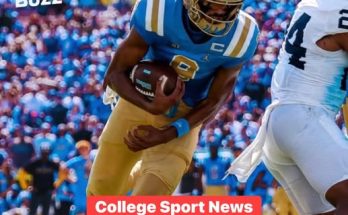In the ever-evolving world of college football recruiting, few decisions generate as much buzz and speculation as a high-profile commitment switch by a top-tier prospect. Recently, the college football universe was rocked when a 4-star standout wide receiver shocked fans, analysts, and recruiting insiders alike by turning down a staggering \$2.5 million offer, decommitting from the prestigious Clemson Tigers, and ultimately choosing Texas A\&M over powerhouse programs Florida and Notre Dame. This dramatic turn of events has not only altered the recruiting landscape but also sparked intense debate about the priorities and motivations of young athletes in today’s highly competitive and monetized recruiting environment.
The player at the center of this storm is widely regarded as one of the nation’s top wide receiver prospects, possessing a rare combination of size, speed, and route-running precision that has scouts raving about his potential impact at the collegiate and even professional levels. His recruitment was closely followed from the beginning, with Clemson emerging early as a favorite given their storied history of developing elite receivers and competing consistently at the highest level in the ACC and nationally. The Tigers had invested considerable time and resources courting this talented athlete, seeing him as a cornerstone for their future offensive schemes.
However, the tides shifted dramatically when reports surfaced that the receiver was offered a lucrative \$2.5 million package as part of the Name, Image, and Likeness (NIL) opportunities tied to his commitment. Such offers have become increasingly common as NIL deals reshape the recruiting landscape, enabling top prospects to leverage their marketability even before stepping onto a college field. The offer to the receiver was said to be one of the largest ever publicly reported in the college football recruiting world, making his subsequent decision to decline it all the more shocking.
The announcement that the receiver had decommitted from Clemson sent shockwaves through the college football community. Recruiting analysts scrambled to assess what this meant for the Tigers’ recruiting class and how the player’s choice would influence the balance of power among top programs. The unexpected twist was not just the decommitment itself but the receiver’s next move — instead of following the NIL money trail or choosing a traditional football powerhouse like Florida or Notre Dame, he pledged his commitment to Texas A\&M, a program that has been steadily rising in prominence under its current leadership and is now a formidable contender in the SEC.
Texas A\&M’s recruiting pitch reportedly emphasized a combination of factors that resonated with the wide receiver. While the monetary NIL offers from other schools were significant, the Aggies sold a vision centered around player development, immediate playing time, a supportive coaching staff, and a chance to make a lasting impact in one of college football’s toughest conferences. The coaching staff at Texas A\&M, known for their ability to nurture wide receiver talent, convinced the athlete that the path to both collegiate success and a future professional career was best realized in College Station.
The decision by this standout athlete highlights a critical and evolving aspect of college football recruiting: the balance between financial incentives and the long-term development and exposure opportunities offered by the program itself. NIL deals, while lucrative and enticing, do not guarantee success on the field or a seamless transition to the NFL. For many prospects, the allure of a program that offers stability, coaching expertise, and a clear pathway to growth remains paramount.
Furthermore, this case underscores the changing dynamics of athlete empowerment in college sports. Today’s recruits are more informed, more strategic, and less willing to be swayed solely by monetary considerations. They are weighing multiple factors, including team culture, coaching staff relationships, academic fit, geographic preferences, and the competitive landscape. This wide receiver’s decision reflects a mature evaluation of these variables, signaling a shift in recruiting that goes beyond simple dollar amounts.
For Clemson, the decommitment is a significant blow, particularly because it came after such a substantial NIL offer was extended. It raises questions about the effectiveness of NIL deals in securing commitments and whether programs need to recalibrate their recruiting strategies to focus more on holistic athlete engagement. The Tigers will now have to recalibrate and possibly pursue other talented prospects to fill the void left by this loss.
Florida and Notre Dame, both strong contenders for the receiver’s signature, also face scrutiny as to why they were unable to close the deal despite their illustrious programs and competitive NIL packages. It suggests that even the most historically successful programs are not immune to the new realities of recruiting, where intangibles like player fit and coaching relationships can outweigh institutional prestige and financial allure.
Texas A\&M’s victory in this recruitment war marks a milestone for the program. It demonstrates the Aggies’ growing ability to attract elite talent despite stiff competition from traditional powerhouses. This signing could signal a broader trend of Texas A\&M emerging as a major player in the national recruiting scene, capable of luring top prospects who value more than just NIL cash. The program’s reputation for player development, combined with its competitive position in the SEC, makes it an appealing destination for prospects looking to maximize their potential.
The ripple effects of this decision extend beyond just the immediate recruiting classes. It challenges other programs to rethink how they engage with recruits in the NIL era. The temptation to focus purely on the financial aspect can sometimes backfire if it overlooks the comprehensive needs and aspirations of athletes. Programs that successfully blend NIL opportunities with strong coaching, academic support, and a welcoming culture are likely to gain the upper hand in future recruiting battles.
Additionally, this story is a testament to the increasing complexity of the college football recruiting landscape. Athletes today have more choices, more platforms to express themselves, and more access to information than ever before. The old model of recruitment driven by program prestige and legacy is giving way to a more nuanced and multifaceted approach where recruits are the true decision-makers, wielding considerable power and autonomy.
the decision by this 4-star wide receiver to turn down a historic \$2.5 million NIL offer, decommit from Clemson, and choose Texas A\&M over Florida and Notre Dame is a landmark moment in college football recruiting. It reflects a sophisticated approach by the athlete in balancing financial incentives with developmental and cultural fit, signaling a shift in how top recruits make their decisions. For Texas A\&M, it is a recruiting coup that could elevate the program’s status on the national stage. For Clemson, Florida, and Notre Dame, it is a wake-up call about the evolving nature of recruitment and the need to adapt strategies in a rapidly changing landscape. Most importantly, it highlights the empowerment of young athletes who now have the tools and agency to shape their futures on their own terms, rewriting the narrative of college football recruiting for years to come.



